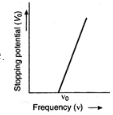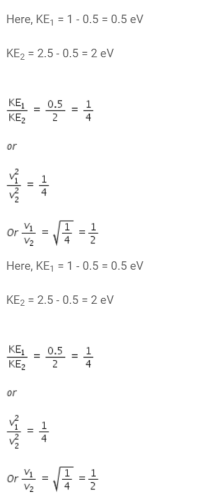All Exams >
EmSAT Achieve >
Chemistry for EmSAT Achieve >
All Questions
All questions of Photoelectric Effect for EmSAT Achieve Exam
The energy of the incident photon is 20 eV and the work function of the photosensitive metal is 10 eV. What is the stopping potential?- a)30 V
- b)5 V
- c)10 V
- d)15 V
Correct answer is option 'C'. Can you explain this answer?
The energy of the incident photon is 20 eV and the work function of the photosensitive metal is 10 eV. What is the stopping potential?
a)
30 V
b)
5 V
c)
10 V
d)
15 V
|
|
Krishna Iyer answered |
Stopping potential (Vo) is given by
Vo=W/q where W is the work function and q are the charge of an electron.
Given W=20eV−10eV=10eV. Also, q=e
Hence, Vo=(10eV)/e=10V
Vo=W/q where W is the work function and q are the charge of an electron.
Given W=20eV−10eV=10eV. Also, q=e
Hence, Vo=(10eV)/e=10V
Photons of energy 6 eV are incident on a potassium surface of a work function 2.1 eV. What is the stopping potential?- a)-3.9V
- b)-8.1V
- c)-5V
- d)-1.9V
Correct answer is 'A'. Can you explain this answer?
Photons of energy 6 eV are incident on a potassium surface of a work function 2.1 eV. What is the stopping potential?
a)
-3.9V
b)
-8.1V
c)
-5V
d)
-1.9V
|
|
Priyanka Sharma answered |
From photo-electric equation, eV0= E−φ
eV0=(6−2.1)eV
V0= 3.9 V
stopping potential is a negative potential to stop e- at saturated current .
eV0=(6−2.1)eV
V0= 3.9 V
stopping potential is a negative potential to stop e- at saturated current .
Light of frequency 1.5 times the threshold frequency is incident on a photosensitive material .If the frequency is halved and the intensity is doubled, the photoelectric current becomes- a)Doubled
- b)Quadrupled
- c)Halved
- d)zero
Correct answer is option 'D'. Can you explain this answer?
Light of frequency 1.5 times the threshold frequency is incident on a photosensitive material .If the frequency is halved and the intensity is doubled, the photoelectric current becomes
a)
Doubled
b)
Quadrupled
c)
Halved
d)
zero

|
Ayush Joshi answered |
If the frequency is halved and intensity is doubled, the frequency of incident light will become 15/2 = 0.75 times the threshold frequency. So, as ν<νo Hence, photoelectric current will be zero.
A photo-sensitive material would emit electrons, if excited by photons beyond a threshold. To overcome the threshold, one would increase the:- a) voltage applied to the light source
- b) intensity of light
- c) wavelength of light
- d) frequency of light
Correct answer is option 'D'. Can you explain this answer?
A photo-sensitive material would emit electrons, if excited by photons beyond a threshold. To overcome the threshold, one would increase the:
a)
voltage applied to the light source
b)
intensity of light
c)
wavelength of light
d)
frequency of light
|
|
Rohan Singh answered |
The emission of photoelectron takes place only, when the frequency of the incident light is above a certain critical value, characteristic of that metal. The critical value of frequency is known as the threshold frequency for the metal of the emitting electrode.

Suppose that when light of certain frequency is incident over a metal surface, the photo- electrons are emitted. To take photoelectric current zero, a particular value of stopping potential will be needed. If we go on reducing the frequency of incident light, the value of stopping potential will also go on decreasing. At certain value of frequency v0, the photoelectric current will become zero, even when no retarding potential is applied. This frequency vq corresponds to the threshold for the metal surface. The emission of photoelectrons does not take place, till frequency of incident light is below this value.

Can you explain the answer of this question below:Light from a bulb is falling on a wooden table but no photo electrons are emitted as
- A:
Work function of wood is less
- B:
Work function of wood is more
- C:
It depends on the frequency
- D:
It is independent of work function
The answer is b.
Light from a bulb is falling on a wooden table but no photo electrons are emitted as
Work function of wood is less
Work function of wood is more
It depends on the frequency
It is independent of work function
|
|
Rishika Patel answered |
Explanation:
When light falls on a metal surface, electrons may be emitted from the metal surface. This phenomenon is known as the photoelectric effect. The electrons emitted from the metal surface are called photoelectrons.
The photoelectric effect can be explained by considering that light is made up of photons. Each photon has a certain amount of energy, given by its frequency. When a photon strikes a metal surface, its energy can be transferred to an electron in the metal. If the energy of the photon is greater than the work function of the metal, the electron can be emitted from the metal surface.
In the case of a wooden table, the work function of the wood is more than the energy of the photons of the light falling on it. Therefore, no photoelectrons are emitted. This is because the energy of the photons is not enough to overcome the work function of the wood.
Key Points:
- The photoelectric effect is the emission of electrons from a metal surface when light falls on it.
- The energy of a photon is given by its frequency.
- If the energy of a photon is greater than the work function of the metal, electrons can be emitted from the metal surface.
- In the case of a wooden table, the work function of the wood is more than the energy of the photons of the light falling on it, so no photoelectrons are emitted.
When light falls on a metal surface, electrons may be emitted from the metal surface. This phenomenon is known as the photoelectric effect. The electrons emitted from the metal surface are called photoelectrons.
The photoelectric effect can be explained by considering that light is made up of photons. Each photon has a certain amount of energy, given by its frequency. When a photon strikes a metal surface, its energy can be transferred to an electron in the metal. If the energy of the photon is greater than the work function of the metal, the electron can be emitted from the metal surface.
In the case of a wooden table, the work function of the wood is more than the energy of the photons of the light falling on it. Therefore, no photoelectrons are emitted. This is because the energy of the photons is not enough to overcome the work function of the wood.
Key Points:
- The photoelectric effect is the emission of electrons from a metal surface when light falls on it.
- The energy of a photon is given by its frequency.
- If the energy of a photon is greater than the work function of the metal, electrons can be emitted from the metal surface.
- In the case of a wooden table, the work function of the wood is more than the energy of the photons of the light falling on it, so no photoelectrons are emitted.
Sodium surface is illuminated by ultraviolet and visible radiation successively and the stopping potential determined. The stopping potential is- a)Greater with visible light
- b)Equal in both cases
- c)Greater with ultraviolet light
- d)Infinite in both cases
Correct answer is 'C'. Can you explain this answer?
Sodium surface is illuminated by ultraviolet and visible radiation successively and the stopping potential determined. The stopping potential is
a)
Greater with visible light
b)
Equal in both cases
c)
Greater with ultraviolet light
d)
Infinite in both cases
|
|
Riya Banerjee answered |
λ for U.V is less than λ for visible light
ν for U.V is greater than ν for visible light
∴ potential is greater for U.V light.
as K.Eα1/λ
ν for U.V is greater than ν for visible light
∴ potential is greater for U.V light.
as K.Eα1/λ
Light of wavelength 4000 Â is incident on a metal of work function 3.2 x 10-19 J. What is the maximum kinetic energy of the emitted electron?
- a)2.2 x 10-19 J
- b)1.75 x 10-19 J
- c)0.75 x 10-19 J
- d)1.1 x 10-19 J
Correct answer is option 'B'. Can you explain this answer?
Light of wavelength 4000 Â is incident on a metal of work function 3.2 x 10-19 J. What is the maximum kinetic energy of the emitted electron?
a)
2.2 x 10-19 J
b)
1.75 x 10-19 J
c)
0.75 x 10-19 J
d)
1.1 x 10-19 J
|
|
Om Desai answered |
Given,
λ= 4000 Å ;W=3.2× 10-19 j
as we know that
K.E = (hc/ λ) - W
= (6.6× 10-34 × 3 × 108/ 4000×10-10 )- 3.20× 10-19
= 1.75 × 10-19
λ= 4000 Å ;W=3.2× 10-19 j
as we know that
K.E = (hc/ λ) - W
= (6.6× 10-34 × 3 × 108/ 4000×10-10 )- 3.20× 10-19
= 1.75 × 10-19
Light of two different frequencies whose photons have energies of 1eV and 2.5 eV respectively successively illuminate a metal of work function 0.5eV. The ratio of maximum speed of emitted electrons is- a)1:5
- b)1:4
- c)1:3
- d)1:2
Correct answer is option 'D'. Can you explain this answer?
Light of two different frequencies whose photons have energies of 1eV and 2.5 eV respectively successively illuminate a metal of work function 0.5eV. The ratio of maximum speed of emitted electrons is
a)
1:5
b)
1:4
c)
1:3
d)
1:2
|
|
Shreya Gupta answered |

The photoelectric threshold frequency of a metal is f0. When light of frequency 4f0is incident on the metal, the maximum K.E. of the emitted electron is- a)2 hf0
- b)4 hf0
- c)3 hf0
- d)hf0/ 2
Correct answer is option 'C'. Can you explain this answer?
The photoelectric threshold frequency of a metal is f0. When light of frequency 4f0is incident on the metal, the maximum K.E. of the emitted electron is
a)
2 hf0
b)
4 hf0
c)
3 hf0
d)
hf0/ 2
|
|
Hansa Sharma answered |
The maximum kinetic energy of the emitted electrons is given by
Kmax=hυ−ϕ0=h(4υ)−h(υ)=3hυ
Kmax=hυ−ϕ0=h(4υ)−h(υ)=3hυ
Chapter doubts & questions for Photoelectric Effect - Chemistry for EmSAT Achieve 2025 is part of EmSAT Achieve exam preparation. The chapters have been prepared according to the EmSAT Achieve exam syllabus. The Chapter doubts & questions, notes, tests & MCQs are made for EmSAT Achieve 2025 Exam. Find important definitions, questions, notes, meanings, examples, exercises, MCQs and online tests here.
Chapter doubts & questions of Photoelectric Effect - Chemistry for EmSAT Achieve in English & Hindi are available as part of EmSAT Achieve exam.
Download more important topics, notes, lectures and mock test series for EmSAT Achieve Exam by signing up for free.
Chemistry for EmSAT Achieve
191 videos|265 docs|160 tests
|

Contact Support
Our team is online on weekdays between 10 AM - 7 PM
Typical reply within 3 hours
|
Free Exam Preparation
at your Fingertips!
Access Free Study Material - Test Series, Structured Courses, Free Videos & Study Notes and Prepare for Your Exam With Ease

 Join the 10M+ students on EduRev
Join the 10M+ students on EduRev
|

|
Create your account for free
OR
Forgot Password
OR
Signup to see your scores
go up
within 7 days!
within 7 days!
Takes less than 10 seconds to signup









